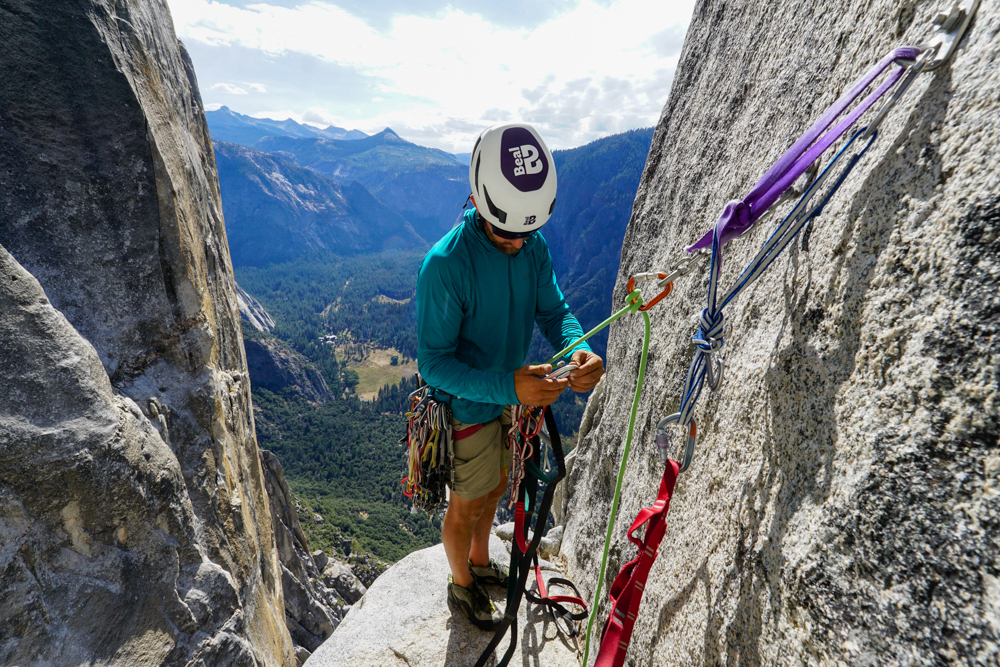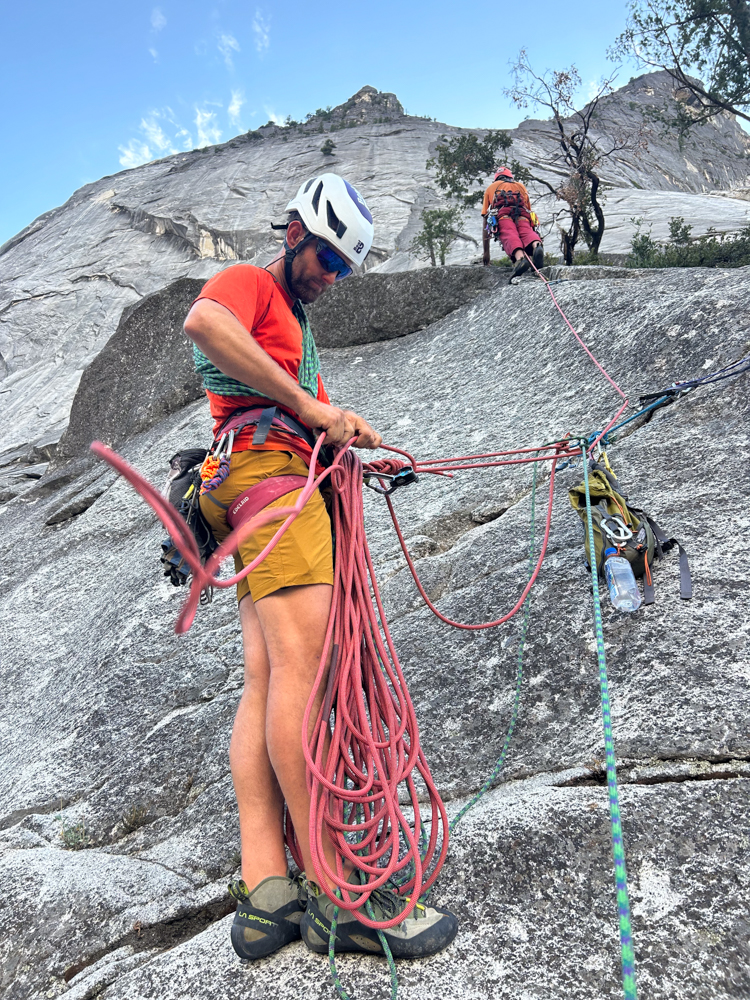ProView – Beal Indy Helmet Review
From California to Utah, the Beal Indy Helmet accompanied me on many routes. From climbing in the alpine of Tuolumne Meadows, on both long single pushes and while cragging in Yosemite Valley, long multi pitch climbs in Red Rock Canyon, and on desert cracks in Indian Creek. I found it to be very comfortable and seemingly weightless no matter where I was during testing.
Beal Indy Helmet

Product Name: Beal Indy Helmet
Product Description: Lightweight, ventilated helmet for optimum comfort.
Offer price: MSRP: $93.60
Currency: USD
-
Quality
(5)
-
Features
(4)
-
Durability
(4)
-
Eco-Friendly
(5)
-
Fit
(5)
Summary
With lightweight foam climbing helmets dominating the market these days, the Beal Indy climbing helmet sets itself apart from the competition with a highly adaptable fit that will fit any head. Couple this with a lightweight design and sleek profile and you get a very competitive helmet that’s as useful for cragging as it is on long alpine pushes.
Overall
4.6Pros
- Wide range of uses (trad, alpine, sport)
- Comfortable
- Lightweight
- Highly customizable sizing
Cons
- No rear headlamp keeper
- Less durable than hardshell helmet options
I received the Beal Indy helmet in Yosemite Valley right at the start of a month long trip that my partner and I had been training for all summer long by climbing in California’s Eastern Sierras. I was excited to hang up my Petzl Sirocco and see what the Beal Indy had in store. Immediately I was bringing it up long, committing routes like the Steck-Salathe and the NW Face of Half Dome. While in between all these bigger routes, the Beal Indy accompanied me on many cragging days in the valley. The Beal Indy didn’t just survive, but rather impressively made it through all of the approach trail bush-whacking, squeeze chimneys, and long days almost entirely unscathed which I was highly impressed by. I have been using the lightweight foam style helmets for years which have ranged greatly in their durability as well as their usefulness on different styles of climbing. I found the Beal Indy to be on the more useful and durable side of these helmets. After Yosemite, we stopped back through Tuolumne Meadows and Red Rock Canyon on our way to Indian Creek where the Beal Indy helmet confirmed my thoughts that it was truly a superb helmet.



Performance
When I unboxed the Beal Indy I was immediately impressed with the customizability of the internal helmet straps. The internal straps allow you to move the strap that goes around the back of your head up and down as well as tighten it unlike many helmets where there is a plastic “bar” of sorts here that you tighten down. You can also adjust the “ears” of the chin strap so they don’t run down the sides of your ears or pin your ear lobe which was a very nice addition. I do wish this strap was a touch longer though because loosened all the way the strap still just barely clears the bottom of my ear lobe. What is really impressive about this setup is that the Beal Indy can quickly and easily be adjusted to fit someone else’s head. That way if your partner forgets their helmet or for those sport climbers that like to just bring one helmet for the belayer, this is a very good option. That being said, the Beal Indy only comes in one size (55-61cm) so if you are on the smaller end of the helmet size spectrum then this helmet may feel a bit large.


The helmet seemed pretty large at first, but once I placed it on my head and got it adjusted it became almost weightless. The Beal Indy has good balance on the head and doesn’t tend to sag forward like some other helmets I have used in the past. I had a touch of forward sag at times which I would just tighten up my straps real quick and it would no longer be an issue. I have found that this problem usually diminishes as the helmet straps get grimy over time and have a tougher time pulling through the adjuster.
Breathability
A heat wave came through Yosemite Valley just after I received the Beal Indy and I was very pleased with its breathability. The Beal Indy has large holes for breathability while maintaining robust protection around the head.



Durability
The only downside with foam style helmets is that they are not as durable as their hardshell companions. When I say “foam style helmet” I am speaking of the helmets that rely almost entirely on exposed or lightly covered foam as the primary outer layer rather than a robust “hardshell” made of hard plastic or the likes over the top of the internal foam (The Petzl Boreo or the Black Diamond Half Dome are great examples of “hardshell” style helmets). The Beal Indy is very similar to the Petzl Sirocco. They are both foam style helmets where the top of the head is reinforced with a piece of harder plastic. However, unlike the Sirocco, the Beal Indy also has a thinner plastic covering over the rest of the foam to give it a bit more durability. I will say that it is definitely more durable than my other helmets like the Black Diamond Vector or Vapor and my Camp helmet (can’t remember the model) that do not have a reinforced top of the head and probably also similar or a touch less durable than my Mammut Wallrider for reference if you are familiar with any of these other types of helmets.
Room for Improvement
The only thing keeping the Beal Indy from being a complete and total standout is its lack of a rear headlamp keeper in the form of clips or a elastic cord on the back of the helmet. Every other helmet I have ever used and can think of has this feature which is almost vital if you plan to use a headlamp. The lack of this feature makes me skeptical of using the Beal Indy in the alpine environment where you are commonly using a headlamp. Without the rear keeper cord, if anything causes the headlamp strap to slide off the already slick helmet, there is a high likelihood that the front headlamp clips wont be able to hold it and gravity will cause it to fall right off. If Beal added a rear headlamp keeper then this helmet would be a standout for alpine climbing. In the meantime, just be cautious when using your headlamp. I am honestly surprised they didn’t include something like this because the helmet is tailored towards alpine climbing with its other features.
Side note: the Beal Indy comes in a striking color scheme of purple on a white helmet (mine) or white on a purple helmet which I have to say makes it very photogenic. You will definitely stand out in photos rather than the classic issue where you blend into the background of a photograph.



What sets the product apart?
The Beal Indy stands out from the competition with its adjustability and comfort. It is also just about as durable as a lightweight foam style helmet can be. My Petzl Sirocco has lasted years of heavy use and the Beal Indy seems to be a similar helmet with the additional benefit of having a thin plastic coating protecting the foam unlike the Sirocco where the foam is completely exposed.
Who is the product for?
This helmet is a perfect companion for climbers looking for something lightweight, climbers that have trouble getting a helmet to fit correctly, or climbers that may have a reason to get a helmet that can be shared with a belayer, family member, etc. The Beal Indy is also a great choice for those climbers that like lightweight foam style helmets that are looking for a more durable option after their current helmet has inevitably reached the point of retirement from use. That being said, it is also a great option for those with a hardshell style helmet that want something more lightweight without sacrificing too much durability. Although it is still a great option, if Beal adds a rear headlamp keeper, then the Beal Indy may be the single best option for alpine climbers. The Beal Indy excels as a trad and sport helmet and I would expect it to work well for ice and mixed climbing as well, although it was not tested in these regards for this review.



Eco-Friendly
Beal is seriously committed to being an eco-friendly climbing company. Their new production and HQ facility based in France utilizes solar for clean energy production as well as “an innovative waste management system, transforming non-recyclables into resources through upcylcing” as per the Beal website. Beal was an early adopter of eco-friendly practices. They have planted over 2 million trees with one planted for every rope sold since 1997. To top this all off, Beal was the first climbing company to produce 100% recycled ropes which have a 78% reduction in their carbon footprint relative to standard production ropes. When researching into Beal’s environmental work I has assumed it would be positive being a French company and all. However, after reading into Beal’s work more, I am thoroughly impressed.
The Final Word
Aside from the Beal Opera (rope) I didn’t know much about Beal. However, after reviewing their Indy helmet I am so impressed that I am going to have to look into their products more. The quality of the Beal Indy helmet is exceptional. I look forward to using the Beal Indy more and potentially replacing my beloved Petzl Sirocco with it. Time will tell, but the fact that I am considering it emphasizes my impression of the Beal Indy as a stellar helmet. If you are in the market for your first hemet or your fifty-first helmet, I believe the Beal Indy will exceed your expectations.



Shop Beal on Outdoor Prolink. Not a member? Apply today!
About the Gear Tester

Zach Eiten
Zach is an aspiring alpinist, ski mountaineer, climber, and photographer. He is a Wilderness First Responder and frequently volunteers with the Colorado Mountain Club to help train future mountaineers. Zach works part-time as a marine biologist in Alaska and a wildlife biologist here in Colorado. You can catch him climbing around Golden where he lives today.











